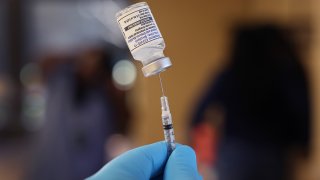
U.S. regulators on Tuesday cleared another booster dose of the Pfizer or Moderna COVID-19 vaccines for older Americans and people with weak immune systems.
The Food and Drug Administration also took steps to make coronavirus vaccinations simpler for everyone, saying that anyone getting a Pfizer or Moderna dose — whether it's a booster or their first-ever vaccination — will get the newest formula, not the original shots.
The FDA said those 65 or older can opt to roll up their sleeves again for another booster as long as it's been at least four months since their first dose of the so-called bivalent vaccine that targets omicron strains.
And most people who are immune-compromised also can choose that extra spring booster at least two months after their first, with additional doses in the future at the discretion of their physician, the agency said.
Get top local stories in Connecticut delivered to you every morning. >Sign up for NBC Connecticut's News Headlines newsletter.
If the Centers for Disease Control and Prevention signs off, those spring boosters could begin within days. The CDC's advisers are set to meet Wednesday.
Read more
“COVID-19 remains a very real risk for many people,” FDA vaccine chief Dr. Peter Marks said.
It's too soon to know if younger, healthy people will eventually be offered yet another shot but the extra dose for the most vulnerable is one of several steps FDA is taking to simplify COVID-19 vaccinations going forward.
Here are some things to know:
ONE FORMULA FOR PFIZER AND MODERNA SHOTS
COVID-19 vaccines have saved millions of lives but protection wanes over time and as new, more contagious variants have popped up. So last fall, Pfizer and Moderna rolled out updated “bivalent” boosters that added protection against omicron strains then circulating to the original vaccine recipe. Tuesday, the FDA said that updated formula will be used for anyone getting a Pfizer or Moderna vaccine. For unvaccinated adults, that means one combo shot would replace having to get several doses of the original vaccine first.
WHO NEEDS A BOOSTER?
Anyone who's gotten their original vaccinations but hasn't had an updated booster yet can still get one. Only 42% of Americans 65 and older — and just 20% of all adults — have gotten one of those updated boosters since September. “Those individuals certainly could go out and get a bivalent booster now to improve their protection,” Marks said.
SOME PEOPLE ARE AT HIGHER RISK
For many Americans, COVID-19 has become less of a health fear and more of an inconvenience, and masking, routine testing and other precautions have largely fallen by the wayside. But at least 250 people in the U.S. a day still die from COVID-19, and high-risk Americans who last got a dose in the fall have anxiously wondered when they could get another.
Letting seniors and the immune-compromised get an extra booster dose puts the U.S. in line with Britain and Canada, which also are offering certain vulnerable populations a spring shot. It’s a reasonable choice, said Dr. Matthew Laurens of the University of Maryland School of Medicine.
“We do have vaccines that are available to protect against these severe consequences, so why not use them?” he said. “They don’t do any good just sitting on a shelf."
WILL YOUNGER, HEALTHIER PEOPLE GET A FALL DOSE?
Stay tuned. The FDA will hold a public meeting in June to consider if the vaccine recipe needs more adjusting to better match the latest coronavirus strains — just like it adjusts flu vaccines every year. And part of that discussion will be whether younger, healthier people also need a booster.
The updated Pfizer and Moderna shots being used now target the BA.4 and BA.5 omicron versions, which have been replaced by an ever-changing list of omicron descendants. Still, while protection against mild infections is short-lived, those updated doses continue to do a good job fighting severe disease and death even against the newest variants, Marks said.
Whether the recipe gets adjusted again or not, Tuesday's move “is essentially preparing to have a simpler, more straightforward way of going about vaccinating people," he said. “It’s essentially a single dose of the appropriately strained vaccine as we move into the fall and winter months.”
TWEAKS TO CHILD SHOTS, TOO
Millions of U.S. children still haven't gotten their initial COVID-19 vaccinations but Tuesday's step means they, too, can get the most updated version of the shots. Tots ages 6 months through 5 years who are unvaccinated can choose two Moderna shots or three of the Pfizer-BioNTech version. Children who are 5 years old can get two Moderna doses or a single Pfizer shot.
Children already fully or partially vaccinated with the original Pfizer or Moderna shots may get a bivalent vaccine, but how many doses will depend on their vaccination history, the FDA said.
WHAT ABOUT THE NOVAVAX VACCINE?
Novavax makes a more traditional type of COVID-19 vaccine, and its original formula remains available for people who don't want the Pfizer or Moderna option. Novavax said Tuesday it also is getting ready in case FDA urges a fall update, by manufacturing several additional formulas.



